|
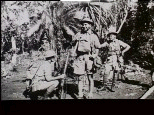
AWM P02235.002 | Darwin, Northern Territory, February 1942: Australians of the 23rd Reserve Motor Transport Unit with full kit and rifles on a training exercise during which they prepared for a possible Japanese invasion of Australia. |

AWM 132532 | Darwin, Northern Territory, 19 February 1942: Oil tanks on Stokes Hill, Darwin, during the first Japanese air raid on Australia. |

AWM 027800 | Darwin, Northern Territory, 12 November 1942: Sergeant F. R. Wombey, MM (Military Medal), 14th Australian Heavy Anti-aircraft Battery. Sergeant Wombey and Gunner W T Hudson were the first two Australians to be decorated for bravery in action on the soil of the Australian mainland. During the first Japanese air raid on Darwin on 19 February 1942, Sergeant Wombey (then Lance Bombadier Wombey) was manning an anti-aircraft light machine position at the Naval Oil Tanks at Darwin. He ordered his gun crew to safety as he himself stood his ground and fired continuously as the position was attacked by enemy dive bombers and fighters. |
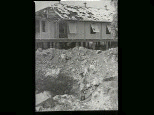
AWM 012784 | Darwin, Northern Territory, February 1942: A bomb crater beside a home in Darwin shortly after a Japanese air raid. |

AWM 128107 | Darwin, Northern Territory, 19 February 1942: Two ships – the Barossa and the Neptuna – on fire in Darwin harbour during the first Japanese air raid on Australia. The depth charges in the hold of the Neptuna eventually detonated causing the biggest explosion of the raid. Two devastating attacks on that day destroyed many buildings, sank or damaged ten naval and merchant vessels, and killed 243 people, both military personnel and civilians. During the Pacific war, of all Australian centres Darwin experienced the most air raids. |
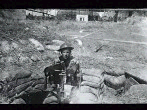
AWM P01794.007 | Darwin, Northern Territory, February 1942 in a sandbagged foxhole an Australian soldier waits with his twin Vickers .303 calibre machine gun for attacking Japanese aircraft. Behind him are the ruins of RAAF Headquarters Darwin destroyed in the first Japanese raid on Darwin of 19 February 1942. |

AWM P01791.005 | Darwin, Northern Territory, February 1942: Graves of the 25 Australian civilians killed during the first Japanese air raid on Darwin on 19 February 1942. They were all killed when a bomb hit the Darwin Post Office. |

AWM P00913.002 | Darwin, Northern Territory, 4 March 1942: An aerial photograph of Darwin taken from a Japanese reconnaissance aircraft at a height of approximately 3,500 feet. |
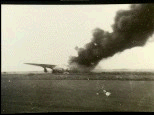
AWM P02039.003 | Broome, Western Australia, March 1942: Smoke rises from one of the six aircraft destroyed at the Broome airfield during a raid by six Japanese Zero fighters on 3 March 1942. Most of these aircraft had just arrived with refugees from the Dutch East Indies and seventy of them were killed. Apart from Broome Japanese air raids were also mounted on the following northern Australian coastal towns – Wyndham, Derby, and Port Hedland, Western Australia; Townsville, Queensland; Darwin, Northern Territory. |
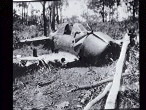
AWM P00022.002 | Melville Island, Northern Territory, 27 February 1942: The first Japanese aircraft to crash land on Australian soil, an Imperial Japanese Navy Mitsubishi Zero B11-1. It was flown by Sergeant TOYOSHIMA Hajime from the aircraft carrier Hiryu. |
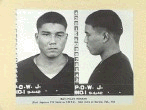
AWM 068530 | Australia, 9 April 1942: Prisoner-of-war identification photographs of Sergeant TOYOSHIMA Hajime, the first Japanese POW to be taken on Australian soil. TOYOSHIMA, after taking part in an air raid on Darwin on 27 February 1942, crash landed his Zero fighter on Melville Island where he was captured by local Aborigines at the Snake Bay settlement. TOYOSHIMA, who had flown in the first air raid on Darwin on 19 February 1942, was later incarcerated in Cowra POW Camp, New South Wales. On the night of 4/5 August 1944 he participated in the mass Japanese POW break-out from the camp and was killed. TOYOSHIMA blew the bugle which signalled the beginning of the escape attempt. The bugle is now in the collection of the Australian War Memorial, Canberra. |

AWM P00022.001 | Bathurst Island, Northern Territory, 27 February 1942: Sergeant TOYOSHIMA Hajime, Imperial Japanese Navy, and his captor Sergeant Leslie Powell, 23 Field Company, Royal Australian Engineers. TOYOSHIMA, after his Zero fighter crash-landed on Melville Island was captured initially by Aborigines from the Snake Bay settlement. They took TOYOSHIMA’s pistol from him and handed TOYOSHIMA and the pistol over to Sergeant Powell who was unarmed. |
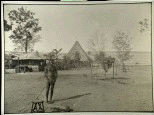
AWM P02305.018 | Snake Bay settlement, Melville Island, Northern Territory, October 1942: When the Pacific war broke out John Gribble, the European warden of this Aboriginal settlement, was appointed a coastwatcher and commissioned into the RANVR (Royal Australian Navy Volunteer Reserve). On 27 February a patrol from Snake Bay captured Sergeant TOYOSHIMA Hajime, the first Japanese prisoner of war to be taken on Australian soil. TOYOSHIMA crash landed his Zero fighter on Melville Island after taking part in an air raid on Darwin. |
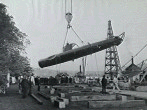
AWM 306616 | Japanese midget submarine No. 21, which took part in a raid on Sydney Harbour on the night of 31 May/1 June 1942, being lowered on to blocks on shore after its raising from the harbour bottom. No. 21 was one of three Japanese midget submarines which tried to penetrate the harbour defences. One became entangled in the boom and was scuttled by its crew. Another went up the harbour where it fired a torpedo at the cruiser USS Chicago. The torpedo missed and sank a harbour ferry, the HMAS Kuttabul, which was being used as a barracks ship. Nineteen Australian and British sailors were killed. The third submarine was destroyed by depth charges without having fired any torpedos. |
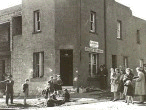
AWM 012589 | Rose Bay or Bellevue Hill?, Sydney, 8 June 1942: Children sit in a crater made by one of four shells fired from Japanese submarine I-24 lying off the New South Wales coast on the night of 8 June 1942. I-24 was one of the carrier submarines from which the midget submarines making the attack on Sydney Harbour on 31 May/1 June had been launched. |

AWM 128885 | On board the Japanese naval vessel Takita Maru, November 1941: Lieutenant MATSUO Keiu, crew member of Japanese carrier submarine I-22 which participated in the submarine attack on Pearl Harbour, Hawaii, USA, on 7 December 1941. On the night of 31 May/1 June 1942 Lieutenant MATSUO took his own life rather than surrender in midget submarine No. M-22. His submarine was being depth charged during the Japanese midget submarine attack on Sydney Harbour. His body was recovered, along with three other Japanese submarines, cremated, and the ashes returned by Royal Australian Navy authorities to Japan. |

AWM P00325.001 | Members of Japanese Imperial Navy’s Midget Submarine Attack Group who took part in the simultaneous attacks on Diego Suarez (Madagascar) and Sydney Harbour on the night of 31 May/1 June 1942. All of these Japanese sailors, except one, died either in these or subsequent submarine operations, or as the result of naval accidents. |
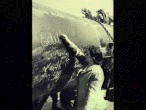
AWM P00455.017 | Melbourne, c. November 1942: A women writes her name on the hull of the Japanese midget submarine on display in the Exhibition Gardens, Melbourne. The submarine, a composite craft made up of parts of two Japanese midget submarines which took part in the raid on Sydney Harbour on the night of 31 May/1 June, was taken on a tour of eastern Australian towns and cities to raise money for the war effort. Small model midget submarines were made from the lead ballast in the submarines and also sold to raise money. |
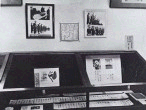
AWM 128897 | Etajima, Japan, c.1942: An exhibition in the Reference Hall, Marine Self-Defence Establishment, Japan, featuring photographs, copies and mementoes of the Japanese midget submarine raid on Sydney Harbour on the night of 31 May/1 June 1942. The photographs at the top of the display are of the funeral ceremony in Sydney of the four Japanese submariners taken from the wreckage of their craft in Sydney Harbour. Their ashes were then returned to Japan. In the case is a copy of the body belt worn by Lieutenant MATSUO Keiu, commander of one of the midget submarines, who committed suicide in his craft before it was destroyed by depth charges. For many years this body belt was in the collection of the Australian War Memorial in Canberra. In 1968 Mrs MATSUO Matsue, Lieutenant MATSUO’s 83-year-old mother, visited the Memorial where her son’s belt was restored to her. On this visit she thanked the Australian people for the way they had treated her son’s remains. For the occasion she also wrote a number of short poems of which this is one:
It was for the Emperor that I raised my flower
But now the storm has blown it away
It is I who am lonely. |
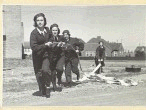
AWM 027454 | Melbourne, 1 November 1942: Female members of an Air Raid Precautions unit run out a hose in an air raid exercise. Over 5,000 ARP personnel took part in this exercise. During the early months of 1942 a Japanese invasion of the Australian mainland was thought possible and air raids on Australian towns and cities were anticipated. The threatened invasion never came. The only Australian towns to experience a Japanese air raid were Darwin, Broome and Townsville. |
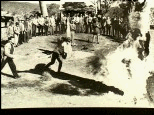
AWM P02018.091 | Australia, c.1942: Members of the Volunteer Defence Corps practise an incendiary exercise with home-made bombs. Most members of the VDC were World War 1 veterans of the 1st Australian Imperial Force which fought in France, Belgium, Gallipoli and the Middle East. The VDC was to engage in guerilla warfare should there be a Japanese invasion of Australia. |

AWM 136772 | Victoria, Australia, 8 September 1942: A wooden model of a Japanese aircraft used to train air raid precaution personnel in aircraft recognition. As Japanese air raids on major Australian cities never eventuated, these models were as close as thousands of Australians involved in air raid duties ever came to an enemy aircraft! |
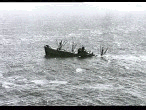
AWM 128144 | Off Port Macquarie, New South Wales, 10 February 1943: The United States Liberty Ship Star King sinks after being torpedoed by a Japanese submarine. During the Pacific war Japanese submarines operating off the east coast of Australia sank 19 Australian and Allied ships. |
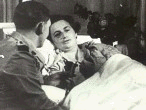
AWM 044428 | Greenslopes Army Hospital, Brisbane, May 1943: Sister Ellen Savage, Australian Army Nursing Service, being interviewed in her hospital bed approximately eight days after the sinking of the Australian Hospital Ship Centaur. The Centaur, a clearly marked hospital ship, was sunk by a torpedo from Japanese submarine I–177 commanded by Lieutenant Commander Nakagawa off the south Queensland coast on the night of 14 May 1943. Out of a complement of 332, 12 of them nurses, there were only 64 survivors of whom Sister Savage was one. The sinking of this unarmed hospital ship was received with great anger in Australia and the ship quickly became a symbol of Australian determination to win the war. Posters appeared in Australia showing the sinking Centaur with the slogan – Avenge the Nurses. |
|